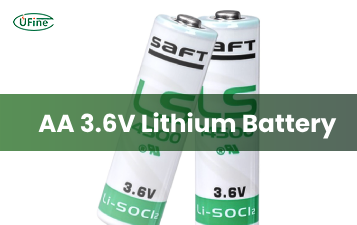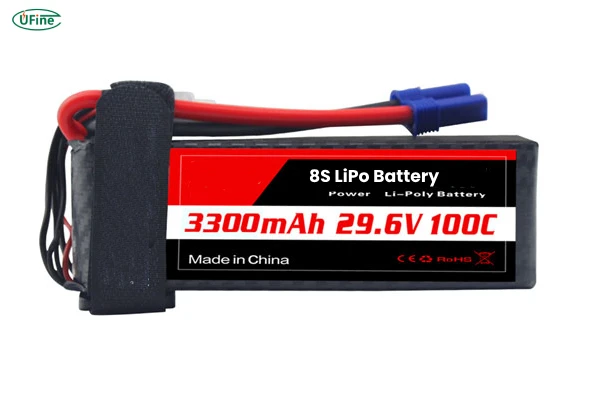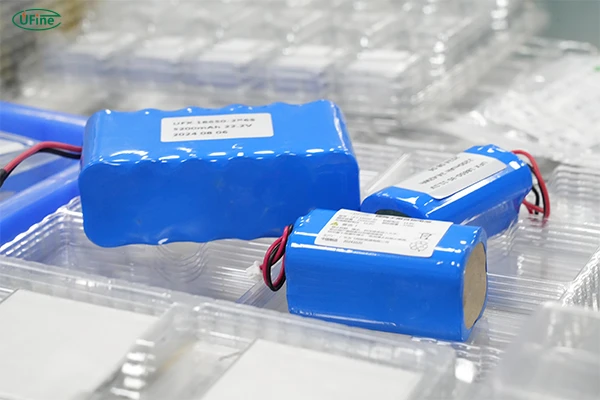If you’ve ever held an 8S LiPo battery in your hand, you already know—it’s not just a battery. It’s a promise of performance, speed, and raw energy. Whether you’re flying high-end drones, building an electric skateboard, or racing RC cars, the 8S LiPo is the silent force pushing your limits.
But power like this isn’t without responsibility. Understanding this battery inside and out can be the difference between optimal performance and damaged gear—or worse, danger. So, let’s dive into the heart of this high-voltage beast.
Part 1. What’s the voltage of an 8S LiPo battery?
Let’s start with the basics. In battery terminology, “S” refers to how many cells are connected in series. So, an 8S LiPo battery contains eight individual cells lined up one after another.
- Each cell has a nominal voltage of 3.7V.
- Multiply that by 8: 3.7V x 8 = 29.6V nominal voltage.
- When fully charged, each cell reaches 4.2V, so total voltage tops out at 33.6V.
That’s a lot of juice—nearly double what you get from a 4S pack. And this high voltage translates to serious acceleration, torque, and speed.
Part 2. Specifications
While all 8S packs share the same voltage, they vary widely in other specs. Here’s what you need to look at when evaluating an 8S LiPo:
- Voltage: 29.6V nominal / 33.6V full
- Capacity: Ranges from 1500mAh to 12000mAh
- Discharge Rate (C-rating): Usually 25C–100C depending on the application
- Configuration: Often 8S1P, but larger packs may be 8S2P or more
- Weight: Can range from 500g to 1500g+
- Size: Varies by use—some are compact, others are brick-sized
Capacity determines runtime, while C-rating tells you how fast the battery can safely discharge its energy. For example, a 5000mAh 50C battery can deliver 250A of current (5Ah × 50C)—enough to power demanding motors with ease.
Part 3. Features
What makes this battery so popular in high-power applications? Here are some reasons users trust the 8S:
🔹 High Power Output
The high voltage delivers instant torque and speed. Ideal for professional RC racers, FPV pilots, and electric mobility devices.
🔹 Lightweight but Powerful
Despite the voltage, it’s still significantly lighter than other chemistries like NiMH or lead-acid.
🔹 Excellent Energy Density
You get more watt-hours per gram compared to older battery tech.
🔹 Versatility
Use it in drones, RC buggies, e-bikes, and industrial machinery. If it needs serious power, the 8S LiPo is probably the right choice.
Part 4. Discharge cable and charging cable
The main discharge cable is where the battery pushes out all that power. It’s usually thick, made from silicone-insulated 10–12 AWG wire, and connected to a high-current connector like XT90 or EC5.
On the other hand, the charging cable, also called a balance lead, connects to each cell. It allows your charger to balance all 8 cells during charging—keeping your battery safe and performing its best.
Part 5. Connector types for 8S LiPo batteries
Choosing the right connector is critical. It’s not just about compatibility—it’s about safety and efficiency.
Common connector types include:
- XT90, XT150 – For mid to high current draw
- AS150 – With anti-spark feature for safer connections
- EC5, EC8 – Excellent for high current transfer
- Custom Connectors – Available for industrial and proprietary systems
The connector must match your ESC or power system, or you risk overheat, resistance, or even sparks.
Part 6. Choosing the right charger for your 8S LiPo
You can’t use any charger here—an 8S LiPo requires a smart charger capable of handling up to 33.6V.
What to Look for:
- 8S compatibility – Obvious, but essential
- Balance charging support
- Over-voltage and over-temp protection
- External power supply for some advanced chargers
Brands like ISDT, iCharger, HOTA, and SkyRC offer 8S-capable models with detailed monitoring tools.
Part 7. 8S LiPo vs. 4S LiPo battery: what’s the difference?
Feature 4S LiPo 8S LiPo Voltage 14.8V nominal 29.6V nominal Size & Weight Smaller, lighter Larger, heavier Power Output Moderate High Common Use RC cars, quadcopters Large drones, e-skateboards, industrial Cost Lower Higher Charging Simpler More complex
If you’re stepping up from a 4S, you’ll immediately notice the punch, speed, and torque from an 8S setup—but also the need for better cooling, monitoring, and charging discipline.
Part 8. Where are 8S LiPo batteries used?
These batteries are not for casual users. You’ll find 8S LiPos powering:
- Professional drones
- High-performance RC cars and boats
- E-bikes and scooters
- Electric surfboards
- Robotics and industrial tools
- FPV wings and long-range aircraft
They’re the go-to solution for any setup that needs serious voltage and sustained current draw.
Part 9. What affects the life of an 8S LiPo battery?
Here are the real-world enemies of your 8S battery:
- Over-discharging below 3.0V per cell
- Overcharging above 4.2V per cell
- Physical damage or puffing
- Leaving it fully charged or discharged for long periods
- Operating in extreme heat or cold
- High discharge currents without proper cooling
Each one of these can shave dozens of cycles off your battery’s life.
Part 10. How to extend the life of an 8S LiPo battery
This is where human care matters. Treat your battery well, and it’ll return the favor.
✅ Tips to Keep It Healthy:
- Always balance charge to keep cells even.
- Store at 3.8V per cell (storage voltage) when not in use.
- Never over-discharge. Stop at 3.5V per cell minimum.
- Let it cool after use before recharging.
- Use LiPo bags or boxes for safe storage.
- Inspect regularly for puffiness or damage.
- Use the right charger—don’t try to hack it.
Part 11. Looking for a custom 8S LiPo battery? Talk to Ufine Battery!
At Ufine Battery, we don’t just supply batteries—we engineer energy solutions. As a Chinese custom lithium battery manufacturer, we provide:
- High-performance 8S LiPo packs
- Custom voltages, capacities, shapes, and connectors
- Specialized LiFePO4, cylindrical, high-rate, ultra-thin, and high/low-temperature batteries
Whether you need a lightweight pack for your drone, a powerful one for an e-bike, or a custom shape for a tight enclosure, we’ve got you covered.
Visit us at UfineBattery.com or contact us to discuss your project. Let’s build the perfect battery together.
Part 12. FAQs
Can I use two 4S LiPo batteries instead of one 8S?
Yes, if connected in series properly. But make sure they are identical in age, capacity, and charge level.
What happens if I overcharge an 8S LiPo?
It can swell, catch fire, or explode. Never charge above 4.2V per cell.
How many cycles does an 8S battery last?
Typically 200–400 cycles, depending on usage and care.
Can I travel with an 8S LiPo on a plane?
Most airlines have strict watt-hour limits. Check before flying—it might be over the limit.
Can I charge an 8S LiPo battery using a solar panel?
Yes, it’s possible—but it requires careful setup. You’ll need a solar charge controller that supports lithium-ion batteries and outputs a consistent voltage suitable for 8S packs. The solar system must also provide enough current. It’s not the most common charging method, but it can be very effective for off-grid setups, especially in remote drone operations or solar-powered vehicles.
Why do 8S LiPo batteries sometimes puff or swell?
Swelling, or “puffing,” is usually caused by gas buildup inside the cells, often due to:
- Overcharging
- Over-discharging
- High discharge rates with poor cooling
- Charging too fast
- Aging cells
Once a pack starts swelling, it’s unsafe to use. Always store and charge your battery in a LiPo-safe bag and monitor for early signs of failure.
Can I repair a damaged 8S LiPo battery?
It’s not recommended to repair a damaged LiPo battery yourself. Even if only one cell is compromised, trying to open or rewire the pack can lead to short circuits, fires, or chemical burns. If a battery shows signs of damage (puncture, puffing, overheating), the safest move is to dispose of it at a certified recycling center.
What’s the ideal temperature range for using an 8S LiPo battery?
LiPo batteries perform best in moderate temperatures, ideally between 15°C and 35°C (59°F–95°F). Using them in cold weather can drastically reduce output and runtime. In high heat, the cells risk overheating or swelling. Always warm the pack in cold climates and allow cooling time in hot environments to maximize both performance and lifespan.
Related Tags:
More Articles

What You Need to Know About AA 3.6V Lithium Battery
Learn all about AA 3.6V lithium batteries—voltage, size, capacity, uses, and the best replacements. Discover why they’re powerful, and highly reliable.
What Are Lithium Salts and Why They Matter in Battery Electrolytes
Lithium salts in electrolytes are key to battery performance, powering everything from phones to EVs and shaping the future of clean energy.
Lithium AAA Battery Guide: Power, Performance & Chargers
Explore lithium AAA batteries—voltage, capacity, weight, top brands, and more. Learn how to choose the best battery for your device and why it really matters.
How to Calculate Watts, Volts, and Amps (With Simple Formulas and Examples)
Learn how to calculate watts, volts, and amps for lithium batteries with simple formulas and examples, ideal for EVs, solar, and energy systems.
Comprehensive Analysis of U.S. Tariffs on Chinese Lithium Batteries
U.S. tariffs on Chinese lithium batteries in 2025 impact costs, supply chains, and EV, energy storage, and electronics industries globally.






